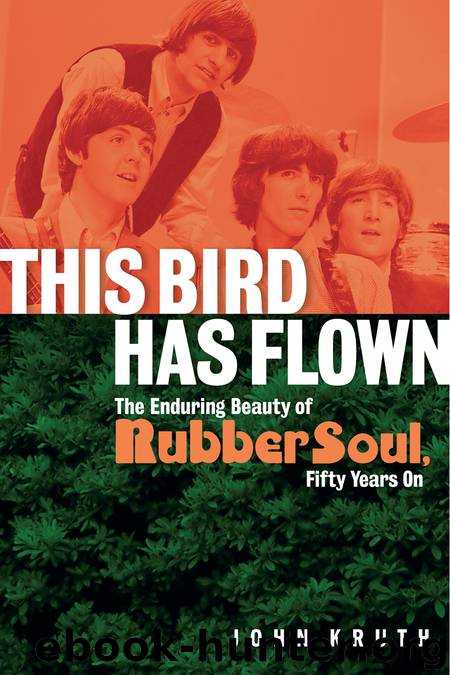This Bird Has Flown by John Kruth

Author:John Kruth
Language: eng
Format: epub
Tags: music history
Publisher: Backbeat
Published: 2016-01-22T05:00:00+00:00
Recorded on October 13, “Day Tripper,” (originally Lennon’s brainchild) was built on a killer guitar riff inspired by the Beatles’ old friend Roy Orbison’s “Oh, Pretty Woman,” which had spent three weeks at the top of the UK charts in August of ’64.
“‘Day Tripper’ is one of the great riffs of the day,” said Lenny Kaye (author and guitarist with Patti Smith). “I was a beginner guitar player back then and had just learned my first rock chords. It was easier to play the Stones or the Yardbirds. The Beatles stuff was always more difficult. By then their sonic palette was really starting to expand. In a weird way, they weren’t part of their time. They transcend their era and stand apart from everyone.”
A writer at Time magazine theorized that “Day Tripper” was inspired by a prostitute, while “Norwegian Wood” portrayed a difficult relationship with a lesbian. Queried by a journalist as to what his intent was behind their new songs, Paul quipped, “We’re just trying to write songs about prostitutes and lesbians, that’s all.” Incidentally, there was a last-minute change made to the song’s original lyric, after John and Paul were admonished that “prick teaser” was absolutely unacceptable. “Big teaser” it was unanimously agreed, was more suitable for radio play.
“Day Tripper” followed in the funky footsteps of “She’s a Woman” (released November 1964 as the B-side of “I Feel Fine”) and “Drive My Car.” But despite its infectious lead riff (that every kid in the UK and the States who played guitar at the time had to learn), Lennon and McCartney considered it a “forced” composition, as they were under the gun to produce fourteen tunes for the new album within a one-month period. They nailed “Day Tripper” on the third take, on October 16, a couple days after “Drive My Car.”
“Day Tripper,” as it turned out, was more popular in Britain, topping the charts at number one while it peaked at number five in the U.S., where “We Can Work It Out” held the top slot. The song took dead aim at “weekend hippies.” “Day Trippers,” Lennon pointed out, “are people who go on a day trip, right? Usually on a ferry boat or something.”
Georgia soul shouter Otis Redding was so moved by “Day Tripper” that within the year he recorded it with his backup band Booker T. and the MGs for his album Dictionary of Soul. Redding’s rendition featured a slinky organ part and punchy horns and was peppered with plenty of Otis’s trademark “gotta, gotta, gottas” to make sure you knew he meant business.
Lennon routinely dismissed most other artists’ recordings of Beatle songs, although they helped increase his newfound wealth. Surprisingly, he didn’t care much for Otis Redding’s sweat-busting cover of “Day Tripper,” while he was very complimentary of Judy Collins’s earnest reading of “In My Life.”
Both Rubber Soul and the Beatles’ new double A-sided single—“Day Tripper,” backed with “We Can Work It Out”—were released on December 3, 1965 (the same day as Rubber Soul in the UK).
Download
This site does not store any files on its server. We only index and link to content provided by other sites. Please contact the content providers to delete copyright contents if any and email us, we'll remove relevant links or contents immediately.
The Social Psychology of Inequality by Unknown(2937)
Make Comics Like the Pros by Greg Pak(2852)
Stacked Decks by The Rotenberg Collection(2811)
Purple Hibiscus by Chimamanda Ngozi Adichie(2648)
The Queen of Nothing by Holly Black(2491)
The Art of Doom by Bethesda(2106)
Life of Elizabeth I by Alison Weir(2026)
Putin's Labyrinth(1959)
The Power of Habit: Why We Do What We Do in Life and Business by Charles Duhigg(1937)
Drawing Down the Moon by Margot Adler(1824)
Things Are What You Make of Them: Life Advice for Creatives by Adam J. Kurtz(1816)
Wall and Piece by Banksy(1779)
Agency by William Gibson(1777)
Art Of Atari by Tim Lapetino(1746)
Teaching to Transgress: Education as the Practice of Freedom (Harvest in Translation) by Bell Hooks(1693)
The Beatles Lyrics by Hunter Davies(1670)
The Pin-Up Art of Bill Ward by Bill Ward(1651)
Only What's Necessary: Charles M. Schulz and the Art of Peanuts by Chip Kidd(1644)
The Andy Warhol Diaries by Andy Warhol(1560)
